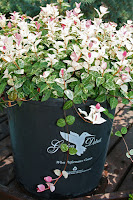The Southeast Regional Symposium of The Herb Society of America was held Oct. 12-13, 2012 in Athens, Georgia.
First we visited the UGA Trial Gardens and Dr. Allan Armitage showed us around.
 |
| Albuca spiralis 'Fizzle Sizzle' |
We saw plenty of flowers, annuals, perennials, roses, vines and the odd foliage plant!
 |
| Solanum wendlandii, Paradise Vine |
 |
| Vince Dooley w The Rising Sun Redbud |
From there, we visited the specactular garden of UGA Coach Vince Dooley (retired legend), shown here with
The Rising Sun Redbud PP21451 .
 |
Pierced Hedge reveals St. Francis Statue
|
There were plenty of details to soak up in the Coach's garden, like the opening cut into this solid hedge, revealing additional gardens beyond, and a serene St. Francis of Assisi statue.
 |
| 14 inch retaining wall |
I hope to re-create a version of this low retaining wall in my own back yard which is sloped.
Here is Coach Dooley's gemlike Japanese Garden.
 |
| Japanese Garden at Coach Dooley's |
 |
| Geri Laufer speaking on Tussie-Mussies |
 |
| I peeked and saw I got a 10+ in the evaluation! |
The next day we had a series of programs for the educational symposium, including my talk on Tussie-Mussies and the Language of Flowers.
There was a lot of history of carried and worn flowers, and the floral language.
 |
| Knot Garden at the State Botanical Garden |
 |
| Rosemary in Bloom! |
 |
| Snowflake Scented Geranium |
 |
| Geri in Vitex with Boxwood in foreground |
The gnarly old Vitex at the State Botanic Garden made a cool place to sit, and in front of me were planted large, venerable plants of
Golden Dream Boxwood PP16052 from Garden Debut(R).
All in all I had a very nice trip, although this speaking engagement meant I had to miss the 2012 Tucson Garden Writers Association conference this year because of the conflict in dates! Thanks for driving, Sue!
 |
| Caladium container at State BG |



















































